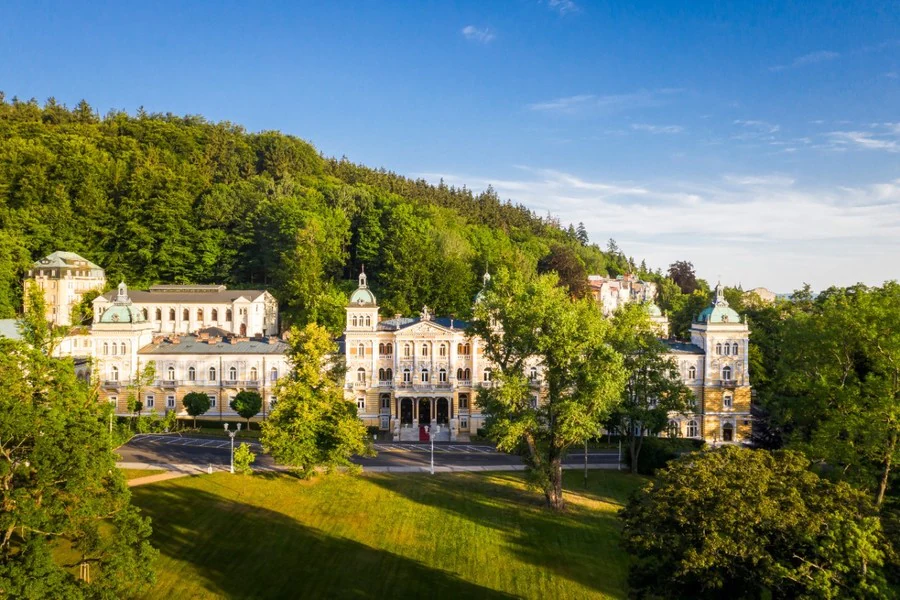Wellness & Relaxation
Benefits for wellness stays
Discover spas in our destinations
Budapest
Hévíz
Mariánské Lázně
Piešťany
Sárvár
Smrdáky
Sovata
Sts. Constantine and Helena
Budapest
Budapest
Budapest’s many historic spas and 120 hot thermal springs map the city’s history starting from the Roman and Ottoman empires, to the 19th century Széchenyi Thermal Baths, a complex of 21 pools and the most photographed spa in Europe, to its epithet as the world’s ‘Spa City’, which Budapest was called in the 1930s. To this day, the Hungarian capital is home to the largest, oldest and grandest spas in all of Europe.

Hévíz
Hévíz
Hévíz is home to the largest thermal lake in the world, suitable for bathing, where guests can enjoy year-round wellbeing thanks to the Mediterranean climate and perfectly warm, mineral-rich water. Aside from the myriad health benefits of the lake, Hungary Hévíz offers everything for a perfect holiday: from culture and culinary events, water sports to local wine, hiking, even ballooning over the tree tops.

Mariánské Lázně
Mariánské Lázně
Mariánské Lázně is the model European spa town with its defining blend of healing natural resources, architectural splendour and more than 200 years of famous visitors such as Chopin, Goethe and King Edward VII whose Royal Cabin still exists in our hotel Nové Lázně.

Piešťany
Piešťany
Piešťany’s peacock emblem refers to the legend of the bird who wallowed in the island’s muddy swamps until its broken leg was healed. The island’s other symbol, a bronze crutch breaker, is also testimony to the power of the sulphurous muds and hot thermal water, that have given Piešt’any its centuries-long, global reputation for healing muscular skeletal and locomotive conditions.

Sárvár
Sárvár
Sárvár is an architectural delight with its famous 16th century, moated Nádasdy Castle. Its long spa history earned the town membership Royal Spas of Europe Association in 2004. It is also home to an arboretum of 300 tree species and flowering shrubs, some planted four centuries ago by the castle’s royal patrons. This 40-acre botanical garden of rare, exotic plants, is open for visitors, together with the town’s museum, churches and public spa with adventure pools and sauna world.

Smrdáky
Smrdáky
Smrdáky is a small, rural spa resort in western Slovakia, often referred to as the ‘Slovak Dead Sea’ thanks to the exceptionally high levels of hydrogen sulphide in the mineral water. For this reason the town has been a leading destination for treating skin disorders for more than 400 years. It was also a famous place of healing for soldiers across the Austro-Hungarian empire who were injured in both the Napoleonic and First World wars.

Sovata
Sovata
Sovata is home to the largest heliothermal lake in Europe. It’s a place where naturally-occurring salt water and the sun’s heat allow warm water bathing surrounded by outstanding natural beauty. There is no place quite like Sovata.

Sts. Constantine and Helena
Sts. Constantine and Helena
A destination, combining rich historical heritage and natural resources with modern complexes and high-class services. Sts. Constantine and Helena resort welcomes guests since 1908 and is the very first Black Sea resort in Bulgaria.
Natural Healing Resources
Ensana is Europe’s largest operator of health spas. We are proud that all eight Ensana destinations are located in places of exceptionally rich natural resources with a long history of medical expertise that continues to grow in line with our ongoing scientific research.

Thermal Water
The precious source of health and relaxation. Thermal mineral water is characterised by its naturally warm temperature and rich mineral composition.
Mineral Water
An efficient natural remedy with stress-reducing effects. Waters contain high levels of minerals (an average of 15mg per litre), plus gases and micro elements that are dissolved in the water as it passes through underground rock.
Salt Water
Healing effects for skin diseases, mobility disorders and gynaecological conditions. Salt water and anti-bacterial healing mud at our Ensana hotels in Sovata come from an unusual geological phenomenon: the only natural helio-thermal lake in Europe.
Healing Mud
Great remedy for musculoskeletal disorders and skin diseases. Like thermal and spring water, healing mud is mineral-rich, with a great capacity to benefit a full range of symptoms depending on the specific composition of elements such as bromine, sulphur and magnesium.
Natural CO2
Ideal for improved circulation and pain relief. A natural phenomenon in Mariánské Lázně, the dry gas springs emit carbon dioxide that is harnessed for use in different treatments of varying intensity and effect to accelerate healing, in particular reducing blood pressure and improveing circulation.











